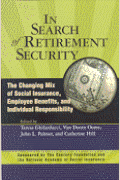Abstract
The shift in the U.S. retirement system away from company pensions and towards individual retirement accounts has placed greater responsibility on workers for ensuring the adequacy of their saving and managing those savings. Absent ready availability of or familiarity with suitable financial instruments, retirees increasingly are self-insuring against a variety of retirement risks, especially the risk of outliving their assets. One alternative to self-insuring against extended longevity is an insurance product known as a “longevity annuity.” The essence of a longevity annuity is a fixed stream of payments that begins with a substantial delay from the time the contract is purchased—a longevity annuity purchased at age 60 or 65, for example, might begin payments at age 75, 80 or 85. The current market for longevity annuities faces many barriers, ranging from consumer decision making that does not account adequately for longevity risk to the fiduciary concerns of employers to incomplete markets for the hedging of risk by insurance companies. In this paper, we highlight how recent trends have precipitated a need for products that offer protection against longevity risk, consider whether longevity annuities can improve retirement security, highlight barriers to more widespread take-up of longevity annuities, and offer a menu of potential reforms to bolster this fledgling market.
Introduction
The U.S. private retirement saving system has undergone a major transformation over the past 25 years. The rate of worker participation in defined benefit pension plans is now less than half what it was in 1990 and the share of workers covered solely by a defined contribution plan has doubled over the same period. This shift has given workers more flexibility in how they save for retirement and also greater responsibility for ensuring the adequacy of that saving. In addition, for those at the point of retirement, it has shifted the risks associated with transforming wealth into retirement security from retirement plan sponsors to retirees themselves. Absent ready availability of or familiarity with suitable financial instruments, retirees increasingly are self-insuring against a variety of retirement risks, especially the risk of outliving their assets.
One option for addressing the risk of extended longevity is to purchase an insurance product known as a “longevity annuity.” The essence of a longevity annuity is that it provides a fixed stream of payments that begins with a substantial delay from the time the contract is purchased at age 60 or 65, with payments not beginning until age 75, 80 or 85. While the market for deferredincome annuities (DIAs) has blossomed in recent years, many DIAs are sold to individuals in their 50s and almost all are sold with deferral periods of less than 15 years. The current market for true longevity annuities remains very thin.
Although sometimes discussed as financial products, longevity annuities more accurately are characterized as insurance products. A 60 year-old male who purchases a longevity annuity with a 20 year deferral period has only about a 50 percent chance of receiving any payments and the premiums of those in the risk pool who die before reaching the age of first payment support the payments to those who do. This design means that longevity annuities may be better structured to address longevity risk than other financial products. Indeed, theoretical models of the value of longevity annuities show that they can substantially increase retirees’ welfare by offering protection against longevity risk at a much lower cost than strategies predicated on purchase of immediate annuities or gradual decumulation of retirement assets invested in bonds and equities.
There is a wide gulf, however, between the theoretical benefits offered by longevity annuities and real-world markets. Today’s retirees rarely are offered annuities of any sort, let alone longevity annuities, in their workplace retirement plans, and few Americans choose to purchase annuities either within or outside their employersponsored accounts. The barriers to a more robust market for longevity annuities are diverse, ranging from consumer decision making that does not account adequately for longevity risk to the fiduciary concerns of employers to incomplete markets for the hedging of risk by insurance companies.
In this paper, we begin by highlighting how recent trends in the retirement security landscape have precipitated a need among middle- to upper-middle income Americans for products that offer protection against longevity risk. Next we examine the market for longevity annuities, considering whether longevity annuities can overcome some of the barriers that have impeded the growth of the market for immediate annuities and whether—and to what extent—longevity annuities can improve retirement security. The paper then addresses potential barriers to the development of a more robust market for longevity annuities and offers a menu of potential reforms to bolster this fledgling market.
Editor’s Note: The original paper was revised in February 2015. The accompanying policy brief was written in September 2015.











